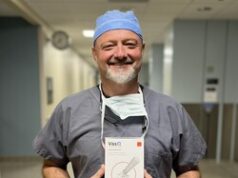
Renal failure affects millions of patients worldwide, with many renal failure patients progressing to end-stage renal disease, requiring dialysis treatment. Dialysis options include central catheters, peritoneal dialysis or haemodialysis via fistulae.
Autogenous fistulae are preferred, but development of these fistulae is a slow process that leads to chronic catheter placement and extra interventional costs. During fistula development, many patients are instructed to do hand exercises or use rubber bands. Some patients are also told that their veins are too small or that the fistula does not have appropriate flow to dilate. This results in more inconvenience, more procedures, frequent readmissions, delayed care and increased costs in caring for renal failure.
A new novel external pneumatic device—Fist Assist (Fist Assist Devices)—may offer a solution to this problem, according to Tej Singh, El Camino Hospital, Mountain View, USA, and president and chief executive officer of Fist Assist Devices.
“Extensive research has shown that intermittent compression help dilate veins after fistula placement via mechanisms like wall tensile stress or nitric oxide release,” Singh told Vascular News. “The Fist Assist was developed and created to help study the clinical role of pneumatic compression on fistula dilation.”
Recently, a large clinical Fist Assist efficacy study was completed at MS Ramaiah Medical Center in Bangalore, India, with the results presented at the 2016 VEITHsymposium (15–19 November, New York, USA) Innovations Session.

One week after arteriovenous fistula (AVF) creation, the Fist Assist was applied 15cm proximal to the AVF in order to apply cyclic compression (of 50mmHg). Thirty patients were test participants and 20 were sham controls. Patients wore the device at home for six hours per day, while vein size was measured and recorded at 30 days by duplex measurement. Clinical results (and percentage increase) were recorded and tested for significance.
“No patients experienced thrombosis or adverse effects,” Singh explained. “Patient compliance and satisfaction was high. After one month, the mean percentage increase in vein diameter in the Fist Assist treatment group was significantly larger (p=0.05) than controls in the first 5cm segment of the fistula. Data were being collected regarding catheter contact time, fistula use, fistula complications on dialysis and three-month follow-up. All fistulae treated with Fist Assist are still functional with no reported thrombosis or extravasations.”
The trial shows, Singh said, “Early application of an intermittent pneumatic compression device may assist in AVF maturation and success. Novel, non-invasive devices like Fist Assist may have clinical utility to create functional fistulae development and decrease costs as they may assist in maturation. The Fist Assist device is an external, medical wearable that can apply intermittent pressure on a specific arm vein to help dilate the vein after fistula placement in a simple non-traumatic way to insure vein enlargement and dilation.”
Singh told Vascular News that larger studies to gather further clinical experience with Fist Assist are planned in 2017 with a focus on patient outcomes and regulatory approval.













